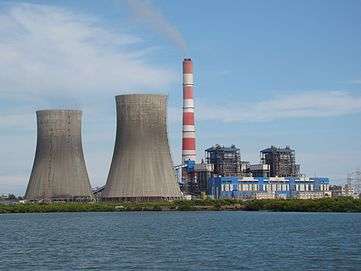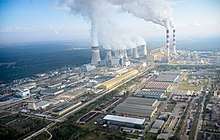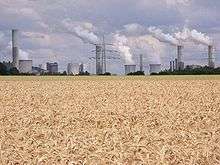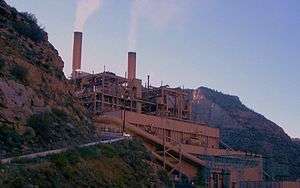Coal-fired power station
A coal-fired power station or coal power plant is a thermal power station which burns coal to generate electricity. Coal-fired power stations generate over a third of the world's electricity but cause hundreds of thousands of early deaths each year, mainly from air pollution.[1]

A coal-fired power station is a type of fossil fuel power station. The coal is usually pulverized and then burned in a pulverized coal-fired boiler. The furnace heat converts boiler water to steam, which is then used to spin turbines which turn generators. Thus chemical energy stored in coal is converted successively into thermal energy, mechanical energy and, finally, electrical energy.
Coal-fired power stations emit over 10 Gt of carbon dioxide each year,[2] almost one fifth of total emissions, so are the single largest source of the greenhouse gases which are causing global warming.[1] They are being retired in Europe[3] and America.[4] As of 2020 plants are still being built in Asia, mostly funded by China.[5][6] There is the risk these plants may become stranded assets.[7]
Operation

As a type of thermal power station, a coal-fired power station converts chemical energy stored in coal successively into thermal energy, mechanical energy and, finally, electrical energy. The coal is usually pulverized and then burned in a pulverized coal-fired boiler. The furnace heat converts boiler water to steam, which is then used to spin turbines which turn generators. Compared to a thermal power station burning other fuel types, coal specific fuel processing and ash disposal is required.
Fuel processing
Coal is prepared for use by crushing the rough coal to pieces less than 5 cm in size. The coal is then transported from the storage yard to in-plant storage silos by conveyor belts at rates up to 4,000 tonnes per hour.
In plants that burn pulverized coal, silos feed coal to pulverizers (coal mills) that take the larger 5 cm pieces, grind them to the consistency of talcum powder, sort them, and mix them with primary combustion air which transports the coal to the boiler furnace and preheats the coal in order to drive off excess moisture content. A 500 MWe plant may have six such pulverizers, five of which can supply coal to the furnace at 250 tonnes per hour under full load.
In plants that do not burn pulverized coal, the larger 5 cm pieces may be directly fed into the silos which then feed either mechanical distributors that drop the coal on a traveling grate or the cyclone burners, a specific kind of combustor that can efficiently burn larger pieces of fuel.
Ash disposal
The ash is often stored in ash ponds. Although the use of ash ponds in combination with air pollution controls (such as wet scrubbers) decreases the amount of airborne pollutants, the structures pose serious health risks for the surrounding environment.[8] Power utility companies have often built the ponds without liners, especially in the United States, and therefore chemicals in the ash can leach into groundwater and surface waters.[9]
Since the 1990s, power utilities in the U.S. have designed many of their new plants with dry ash handling systems. The dry ash is disposed in landfills, which typically include liners and groundwater monitoring systems.[10]. Dry ash may also be recycled into products such as concrete, structural fills for road construction and grout.[11]
Flexibility
A well-designed energy policy, energy law and electricity market are critical for flexibility.[12] Although technically the flexibility of some coal-fired power stations could be improved they are less able to provide dispatchable generation than most gas-fired power plants. The most important flexibility is low minimum load,[13] however some flexibility improvements may be more expensive than renewable energy with batteries.[14]
Coal power generation
As of 2018 coal was the largest source of electricity at 38%, the same share as 20 years previously:[15] the only countries generating over 350 TWh of the total of about 10,000 TWh in 2018 being China (4,732), India (1,176) and the USA (1,246).[16]
As of 2018 coal power under construction was 236 GW, planned 339 GW, and 50 GW was commissioned and 31 GW retired.[17]
Carbon dioxide emissions
As coal is mainly carbon, coal-fired power stations have a high carbon intensity. On average, coal power stations emit far more greenhouse gas per unit electricity generated compared with other energy sources (see also life-cycle greenhouse-gas emissions of energy sources). In 2018 coal burnt to generate electricity emitted over 10 Gt CO
2[2] of the 34 Gt total from fuel combustion[18] (the overall total greenhouse gas emissions for 2018 was 55 Gt CO
2e[19]).
Mitigation
Phase out
The most cost effective way to limit global warming to 1.5 °C, a target of the Paris Agreement, includes EU and OECD countries closing all coal-fired power stations by 2030, China by 2040 and the rest of the world by 2050.[20]
Carbon capture
As of 2019 retrofitting existing coal-fired power stations with carbon capture and storage is being trialled, for example in China, but this reduces the energy output and for some plants may not be technically or economically feasible:[22] the economics of retrofit in China are still being researched.[23]
Pollution
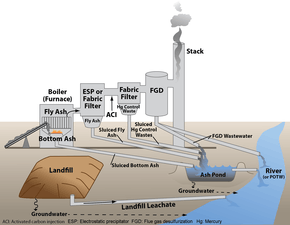
In some countries pollution is controlled by best available techniques, for example those in the EU[24] through its Industrial Emissions Directive. In the United States, coal-fired plants are governed at the national level by several air pollution regulations, including the Mercury and Air Toxics Standards (MATS) regulation,[25] by effluent guidelines for water pollution,[26] and by solid waste regulations under the Resource Conservation and Recovery Act (RCRA).[27]
Coal-fired power stations continue to pollute in lightly regulated countries such as the Western Balkans,[28] India, Russia and South Africa,[29] causing hundreds of thousands of early deaths each year.[1]
Local air pollution
Damage to health from particulates, sulphur dioxide and nitrogen oxide occurs mainly in Asia and is often due to burning low quality coal, such as lignite, in plants lacking modern flue gas treatment.[29] Early deaths due to air pollution have been estimated at 200 per GW-year, however they may be higher around power plants where scrubbers are not used or lower if they are far from cities.[30]
Water pollution
Pollutants such as heavy metals leaching into ground water from unlined coal ash storage ponds or landfills pollute water, possibly for decades or centuries.[31] Pollutant discharges from ash ponds to rivers (or other surface water bodies) typically include arsenic, lead, mercury, selenium, chromium, and cadmium.[26]
Mitigation of local pollution
As of 2018 local pollution in China, which has by far the most coal-fired power stations, is forecast to be reduced further in the 2020s and 2030s, especially if small and low efficiency plants are retired early.[32]
Transport and delivery of coal
Coal is delivered by highway truck, rail, barge, collier ship or coal slurry pipeline. Generating stations are sometimes built next to a mine; especially one mining coal, such as lignite, which is not valuable enough to transport long-distance; so may receive coal by conveyor belt or massive diesel-electric-drive trucks. A large coal train called a "unit train" may be 2 km long, containing 130-140 cars with around 100 tonnes of coal in each one, for a total load of over 10000 tonnes. A large plant under full load requires at least one coal delivery this size every day. Plants may get as many as three to five trains a day, especially in "peak season" during the hottest summer or coldest winter months (depending on local climate) when power consumption is high.
Modern unloaders use rotary dump devices, which eliminate problems with coal freezing in bottom dump cars. The unloader includes a train positioner arm that pulls the entire train to position each car over a coal hopper. The dumper clamps an individual car against a platform that swivels the car upside down to dump the coal. Swiveling couplers enable the entire operation to occur while the cars are still coupled together. Unloading a unit train takes about three hours.
Shorter trains may use railcars with an "air-dump", which relies on air pressure from the engine plus a "hot shoe" on each car. This "hot shoe" when it comes into contact with a "hot rail" at the unloading trestle, shoots an electric charge through the air dump apparatus and causes the doors on the bottom of the car to open, dumping the coal through the opening in the trestle. Unloading one of these trains takes anywhere from an hour to an hour and a half. Older unloaders may still use manually operated bottom-dump rail cars and a "shaker" attached to dump the coal.
A collier (cargo ship carrying coal) may hold 41,000 tonnes (40,000 long tons) of coal and takes several days to unload. Some colliers carry their own conveying equipment to unload their own bunkers; others depend on equipment at the plant. For transporting coal in calmer waters, such as rivers and lakes, flat-bottomed barges are often used. Barges are usually unpowered and must be moved by tugboats or towboats.
For start up or auxiliary purposes, the plant may use fuel oil as well. Fuel oil can be delivered to plants by pipeline, tanker, tank car or truck. Oil is stored in vertical cylindrical steel tanks with capacities as high as 14,000 cubic metres (90,000 bbl). The heavier no. 5 "bunker" and no. 6 fuels are typically steam-heated before pumping in cold climates.
Efficiency
The 4 main types of coal-fired power station in increasing order of efficiency are: subcritical, supercritical, ultra-supercritical and cogeneration (also called combined heat and power or CHP).[33] Subcritical is the least efficient type.
Economics
Subsidies
G20 governments alone subsidize coal by at least US$63.9 billion per year, almost three-quarters of which is for coal-fired power.[1]
Finance
As of 2019 the largest backers are Chinese banks under the Belt and Road Initiative (BRI).[34]
Capacity factors
In 2018 coal-fired power station capacity factor averaged 51%, that is they operated for about half their available operating hours.[35]
Stranded assets
If global warming is limited to well below 2 °C as specified in the Paris Agreement, coal plant stranded assets of over US$500 billion are forecast by 2050, mostly in China.[36] The think tank Carbon Tracker forecast that almost half of the world's col-fired power stations would be cashflow negative in 2020.[37] As of 2020 about half of China's coal power companies are losing money and old and small power plants "have no hope of making profits".[38] As of 2018 India is keeping potential stranded assets operating by subsidizing them.[39]
Politics
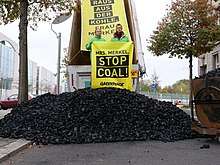
The energy policy of China regarding coal and coal in China are the most important factors regarding the future of coal-fired power stations, because the country has so many.[40] According to one analysis local officials overinvested in coal-fired power in the mid-2010s because central government guaranteed operating hours and set a high wholesale electricity price.[41] As of 2019 BRI investment may be to keep skilled people employed[42] and because banks and state owned enterprises need somewhere to place their capital and expertise.[43]
In democracies coal power investment follows an environmental Kuznets curve.[44] The energy policy of India regarding coal is forecast to result in half of the country's electricity still being generated by coal in 2030.[45]
History

The first coal-fired power stations were built in the late 19th century and used reciprocating engines to generate direct current. Steam turbines allowed much larger plants to be built in the early 20th century and alternating current was used to serve wider areas.
External links
- Coal fired power plant Energy Education by the University of Calgary
- How a coal plant works video by the Tennessee Valley Authority
- How a coal plant works video by Ontario Power Generation
- Electricity from coal by the World Coal Association
- World's coal power plants mapped by Carbon Brief
- End Coal by various environmental, social justice and health advocates
- Coal-fired power by the International Energy Agency
- Economics of coal by Carbon Tracker
- Centre for Research on Energy and Clean Air
References
- "G20 coal subsidies" (PDF).
- "Emissions". www.iea.org. Retrieved 2019-07-04.
- Piven, Ben. "EU power sector emissions drop as coal collapses across Europe". www.aljazeera.com. Retrieved 2020-03-21.
- Roberts, David (2020-03-14). "4 astonishing signs of coal's declining economic viability". Vox. Retrieved 2020-03-21.
- Crooks, Ed (2019-06-30). "The week in energy: China's coal-fired outreach". Financial Times. Retrieved 2019-08-16.
- "Death of coal financing is exaggerated as China steps up". Mining Weekly. Retrieved 2020-03-23.
- Harrabin, Roger (2020-03-12). "Coal power developers 'risk wasting billions'". BBC News.
- Erickson, Camille (October 7, 2019). "Mixing water, Powder River Basin coal ash dangerous to human health, new research finds". Casper Star-Tribune. Casper, WY.
- Brooke, Nelson (June 5, 2019). "New Interactive Maps of Groundwater Pollution Reveal Threats Posed by Alabama Power Coal Ash Pits". Black Warrior Riverkeeper. Birmingham, AL.
- U.S. Environmental Protection Agency (EPA), Washington, D.C. (2010-06-21)."Hazardous and Solid Waste Management System; Identification and Listing of Special Wastes; Disposal of Coal Combustion Residuals From Electric Utilities; Proposed rule." Federal Register, 75 FR 35151
- Scott, Allan N.; Thomas, Michael D. A. (January–February 2007). "Evaluation of Fly Ash From Co-Combustion of Coal and Petroleum Coke for Use in Concrete". ACI Materials Journal. Farmington Hills, MI: American Concrete Institute. 104 (1): 62–70. doi:10.14359/18496.
- "Status of Power System Transformation 2018: Summary for Policy Makers". IEA Webstore. Retrieved 2019-07-03.
- "Flexibility Toolbox". www.vgb.org. Retrieved 2019-07-03.
- "Battery Power's Latest Plunge in Costs Threatens Coal, Gas". BloombergNEF. 2019-03-26. Retrieved 2019-07-03.
- "Electricity | Energy economics | Home". BP global. Retrieved 2019-07-03.
- "BP Statistical Review of World Energy 2019" (PDF).
- "Boom and Bust 2019: TRACKING THE GLOBAL COAL PLANT PIPELINE" (PDF).
- "BP Statistical Review of World Energy 2019" (PDF).
- Environment, U. N. (2019-11-19). "Emissions Gap Report 2019". UNEP - UN Environment Programme. Retrieved 2020-01-22.
- "Coal Phase Out". climateanalytics.org. Retrieved 2019-07-04.
- "Uskmouth Power Station Conversion Project Update and EPP Contract Award". SIMEC Atlantis Energy. 2018-11-05. Retrieved 2019-07-04.
- "Post-Combustion Capture Retrofit: Evolving Current Infrastructure for Cleaner Energy | UKCCS Research Centre". ukccsrc.ac.uk. Retrieved 2019-07-04.
- "Carbon Capture Storage (CCS) in China's power plants". KTH. Retrieved 2019-07-04.
- Commission Implementing Decision (EU) 2017/1442 of 31 July 2017 establishing best available techniques (BAT) conclusions, under Directive 2010/75/EU of the European Parliament and of the Council, for large combustion plants (notified under document C(2017) 5225) (Text with EEA relevance. ), 2017-08-17, retrieved 2019-07-05
- "Mercury and Air Toxics Standards". Washington, D.C.: United States Environmental Protection Agency (EPA). 2019-06-19.
- "Steam Electric Power Generating Effluent Guidelines—2015 Final Rule". EPA. 2019-11-06.
- "Special Wastes". Hazardous Waste. EPA. 2018-11-29.
- "Chronic coal pollution". Bankwatch. Prague: CEE Bankwatch Network. Retrieved 2019-07-05.
- Schipper, Ori (2019-02-18). "The global impact of coal power". ETH Zurich.
- Hausfather, Zeke (2016-11-18). "Coal in China: Estimating Deaths per GW-year". Berkeley Earth. Berkeley, CA. Retrieved 2020-02-01.
- Milman, Oliver (2019-03-04). "Most US coal plants are contaminating groundwater with toxins, analysis finds". The Guardian. ISSN 0261-3077.
- Tong, Dan; Zhang, Qiang; Liu, Fei; Geng, Guannan; Zheng, Yixuan; Xue, Tao; Hong, Chaopeng; Wu, Ruili; Qin, Yu (2018-11-06). "Current Emissions and Future Mitigation Pathways of Coal-Fired Power Plants in China from 2010 to 2030". Environmental Science & Technology. 52 (21): 12905–12914. Bibcode:2018EnST...5212905T. doi:10.1021/acs.est.8b02919. ISSN 0013-936X. PMID 30249091.
- "Coal". www.iea.org. Retrieved 2019-07-05.
- Crooks, Ed (2019-06-30). "The week in energy: China's coal-fired outreach". Financial Times. Retrieved 2019-07-06.
- Shearer, Christine; Myllyvirta, Lauri; Yu, Aiqun; Aitken, Greig; Mathew-Shah, Neha; Dallos, Gyorgy; Nace, Ted (March 2020). Boom and Bust 2020: Tracking the Global Coal Plant Pipeline (PDF) (Report). Global Energy Monitor.
- Saygin, Deger; Rigter, Jasper; Caldecott, Ben; Wagner, Nicholas; Gielen, Dolf (31 May 2019). "Power sector asset stranding effects of climate policies". Energy Sources, Part B: Economics, Planning, and Policy. 14 (4): 99–124. doi:10.1080/15567249.2019.1618421.
- Gray, Matt; Sundaresan, Sriya (April 2020). Political decisions, economic realities: The underlying operating cashflows of coal power during COVID-19 (Report). Carbon Tracker. p. 5.
- "The Path Ahead for China's Coal Power Industry | Hellenic Shipping News Worldwide". www.hellenicshippingnews.com. Retrieved 2020-01-23.
- "India's stranded assets: how government interventions are propping up coal power" (PDF). Overseas Development Institute. 2018.
- David Culver, Lily Lee and Ben Westcott. "China struggling to kick its coal habit despite Beijing's big climate pledges". CNN. Retrieved 2019-10-20.
- Ren, Mengjia; Branstetter, Lee; Kovak, Brian; Armanios, Daniel; Yuan, Jiahai (2019-03-16). "China overinvested in coal power: Here's why". VoxEU.org. Retrieved 2019-07-06.
- "Why Is China Placing A Global Bet On Coal?". NPR.org. Retrieved 2019-07-06.
- "Ep. 93 China's Investment in Coal Around the World – Policy 360 podcast". Retrieved 2019-07-06.
- Urpelainen, Johannes; Zucker, Noah; Clark, Richard (2019-04-11). "Political Institutions and Pollution: Evidence from Coal-Fired Power Generation". Rochester, NY. SSRN 3370276. Cite journal requires
|journal=(help) - "Coal to dominate India power to 2030 despite renewables boost". The Economic Times. 2019-07-02. Retrieved 2019-07-06.
- Ch, Aruna; rasekar (2017-09-26). "Successful Protests Against India's Coal Industry". Climate Tracker. Retrieved 2019-07-06.
- Matthew Robinson. "Hundreds of climate protesters stage blockade in German coal mine". CNN. Retrieved 2019-07-06.
- Leithead, Alastair (2019-06-05). "Row over Kenya World Heritage site coal plant". Retrieved 2019-07-06.
